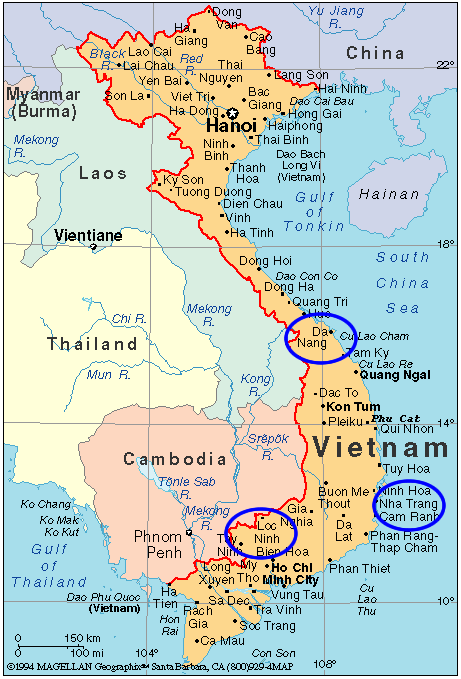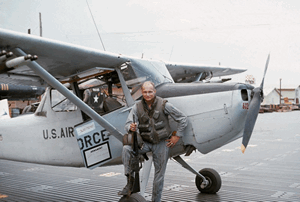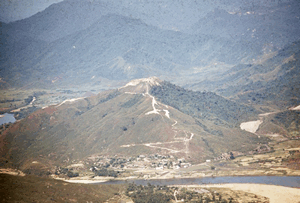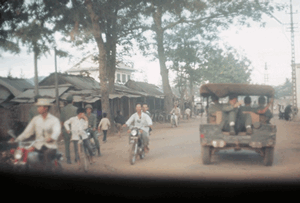
My Vietnam Days
by Al Larson, USAFA Class of 1964
When I volunteered to go to Vietnam, I was assigned to be an O-1 FAC (Forward Air Controller).
I was a bit disappointed in not getting a fighter, but one of the pilots in my T-38 squadron had been an O-1 FAC, and he told me it was a good and important job, especially since you got to tell all the big headed fighter jocks what to do.
 During my tour in Vietnam, I was an O-1 FAC in I Corp, near Da Nang, and III Corp near Loc Nihn, north of Saigon (now Ho Chi Mihn City).
My tour was from November 1968 to November 1969.
During my tour in Vietnam, I was an O-1 FAC in I Corp, near Da Nang, and III Corp near Loc Nihn, north of Saigon (now Ho Chi Mihn City).
My tour was from November 1968 to November 1969.
After checkout at Hulbert Field, survival school at Fairchild AFB in Washington state, and jungle survival school at Clark AFB, in the Philippines, I went through in-country check out at Nah Trang AFB in Vietnam. I had to wait a week for this checkout. I discovered the flight safety officer at Nah Trang had been my flight safety office at Craig AFB ( where we lost 13 aircraft). Jose' Skinner pointed me at the O-1 accident files, and I spent a week reading how people got killed in O-1's in Vietnam. The AF lost about a third of all O-1s flown in Vietnam.
I learned that about half had been lost to small arms fire while flying below the "Gardol shield" of 1500 feet. At 1500 feet, small arms fire drops 100-200 feet from the aim point. So most people shooting at you were unlikely to hit you.
The other half had been lost by doing stupid things, like not securing the oil cap with its safety pin. One particular sad story was about a young lieutenant who flew into a company HQ dirt strip, did his business, then piled 300 pounds of soda pop in the back seat. The O-1 was already above its weight limit, due to the addition of three sets of radio gear needed for the FAC mission. The Lt. took off, but failed to clear the brick shithouse that was just off the end of the runway. The letter to his parents made no mention of the shithouse or the dumb act that got their son killed. He was killed in combat, and died valiantly for his country.
 During that week I also reflected on what my life was worth. I had gotten married just before coming to Vietnam.
After reading Robert Shuler's Life of Christ, I decided that if anything was worth dying for, it was freedom.
If I didn't make it through, it would be God's will. I just decided to try not to do anything stupid.
I nearly succeeded, but I'd still have at least 4 close calls with the Grim Reaper before I was done.
During that week I also reflected on what my life was worth. I had gotten married just before coming to Vietnam.
After reading Robert Shuler's Life of Christ, I decided that if anything was worth dying for, it was freedom.
If I didn't make it through, it would be God's will. I just decided to try not to do anything stupid.
I nearly succeeded, but I'd still have at least 4 close calls with the Grim Reaper before I was done.
I completed my checkout at Nah Trang, and was assigned to the 20th Tactical Air Support Squadron at Da Nang, and attached to Company C of the 5th Special Forces at Da Nang. I was excited that I would be working with the Green Berets.
Da Nang
The beach, and fellow FAC Tom Daniels.
Da Nang Trails
The mountains west of Da Nang are beautiful. The O-1 side windows opened up and latched under the wings. So it was open cockpit flying. Sometimes I felt like Antoine de Saint-Exupery, the French aviator and author who wrote such great stuff about flying the mail routes in the Andes. I'd stick my arm out the window, open up my sleeve, and inflate my fight suit to stay cool. It was sometimes hard to believe the war on the ground existed in the face of such beauty.
Nong Song Special Forces Camp

I got to know many of the Special Forces troops pretty well. One of them was Jerry Jensen, commander of the Nong Song Special Forces camp, perched on this hill about 25 miles southwest of Da Nang. Jerry and four other US Special Forces troops shared the camp with about 10 South Vietnamese Special Forces troops, and 100 CIDG - Civilian Irregular Defense Group. The latter were militia, whose loyalties were often suspect. Two US Special Forces, two RVN Special Forces, and 20-30 CIDG would go out on patrol around Nong Song. If they ran into Viet Cong or sometimes North Vietnamese regular army, a fire fight would ensue, and Tom or I would be out there to help them out of trouble.
Tom and I discovered a trail south of Nong Song that the Special Forces did not know about. They began patrolling it. They captured an NVA full colonel on it. We often found guys carrying shiny 122 MM rockets on it, headed for Da Nang. The villages just outside the camp were not especially friendly. One day they hauled out a 50 caliber machine gun and started hosing me down. It had the range to take me out. Fortunately, the Special Forces guys saw them haul it out, and warned me. A couple of F4 and A4 flights later that gun was gone. After the strike, I had the last F4's buzz Jerry's camp. I didn't know the lead pilot was a two star general. I should have been in trouble, but that night he found us at Marble Mountain and bought me a beer. He said it was the best strike he'd been on.
Besides that pissing contest with the 50 caliber, the only other time I realized I'd almost been had was the day I got a call to go help a patrol near Nong Song. We were not flying because we had an 800 foot ceiling. But the patrol calling for help said it was clear in the valley they were in. So I made my way out there by (stupidly) flying up the overcast, twisting, and steep river valley. I helped the patrol, and returned the same way. I didn't think much of it until my crew chief asked how I got my FM antenna shot off.
Green Berets
The other guy was Bob Burns. Bob had been in a Special Forces camp on the Laotian border when it got overrun by NVA tanks. He was in a bunker driven over by a Russian made tank. Fortunately, the bunker only partially collapsed, and Bob made his escape at night fall. He hiked nearly 30 miles to safety.
On Easter Sunday, 1969, Bob and his patrol stumbled into an NVA base camp, right behind the mountain you see in the background of the photo of Nong Song. I got the mission. We hit the base camp with four flights of F4's. The SF troops were all excited by the bodies they saw flying through the air. And the McNamara's Pentagon got some more KBA's - Killed By Air. What I got was a haunting nightmare about those I had killed. It was thirty years later that I put it to rest after some good therapy.
Later, when I had gone south on the second part of my tour, Bob wrote me a letter. He was going home with a purple heart. His patrol had run into a machine gun nest. He lead the charge up the hill, and got shot in the leg. Bob lay there wondering if he would die there. Would his CIDG run? Or would his CIDG follow him? They followed him. They wiped out the machine gun nest, dragged Bob down the hill, and got him on a medivac chopper. Bob was a great warrior. He also was a great singer and composer. He wrote a great ballad about the war.
Tien Phouc Special Forces Camp
Technically, we were responsible for air support of several other Special Forces camps. Several were too far for us to serve on a daily basis, so we would visit them on a rotation basis, or when they really needed help. In March of 1969, one of these camps, Tien Phouc, came under heavy siege. They were getting rocket attacks, mortar attacks, and ground attacks. The camp was in a valley that was constantly completely socked in. Some days, not even the Army choppers could get in. And with the cloud cover, air support was not feasible, except for one aircraft- the Navy A6. The A6 had a drum based computer on board, and a radio beacon system whereby it could home in on a ground based beacon, and drop computed controlled bombs by navigating off the beacon.
Col. Albright got us an A6 beacon, and he, Tom Daniels, and I rotated duties being Forward Air Controller at Tien Phouc- on the ground, in the dark, in zero zero weather. It was incredible for me to walk 500 pounders from 200 yards out to right up to the camp's perimeter fence. I'd never been that close to these bomb explosions. They were scary, and loud.
With this use of air power, we broke the siege. We each got a Bronze star with V for this operation. To me, it was just part of the job. It was an honor to spend time in that camp with the hard core Green Berets, whose whole life was about fighting for freedom, any place, any time.
I Become A Green Beret
It was the practice of the Air Force to move FACs after about 6 months. So I was assigned to III Corps. Before I left, the Green Berets gave me one of my greatest honors. They made me an honorary Green Beret, completed with plaque and my very own green beret.
I was also given a Russian made SKS rifle, by a Green Beret who had taken it off the battle field. I still have it in my office.
This was a very great honor, coming from men seasoned in battle.
As the war raged around them, the average Vietnamese kept doing what they had done for hundreds of years. I caught this shot of fishermen headed home south of Da Nang.
Hon Quan (An Loc)
a note: most places in Vietnam had two names- the Vietnamese name, and the French name, from the time that Vietnam was a French colony
When I was sent south, I was first assigned to Song Be, in support of the US Army. This was an interesting place to fly into. The "runway" was the little street that ran up to the door of the province capital. At the other end, it was a sheer cliff. But it was 800 feet, so it was fine for an O1. That down draft off the cliff was a bit tricky on landings. Taking off one way and landing the other was also interesting, because one was with a tailwind.
Arriving at Hon Quan, I found myself in charge of my own air force base, 7 personnel, and two O-1s. I had two FACs, a first sergeant, two radio operators, a crew chief, and myself. In addition, we had a 14 year old boy named Lon, who was an assistant crew chief. Lon was a volunteer, who we paid a few dollars out of our pockets. He had adopted the unit three years before, and had become as good an 0-1 mechanic as my AF trained crew chief.
Hon Quan Air BAse
Hon Quan, province capital (right photo). Our 800 foot dirt strip is on the top edge of the town. The Special Forces camp where we lived is the reddish rectangle on the lower right. The dark green vegetation is rubber trees, the local cash crop - and a good place for Viet Cong to hide and fire rockets or mortars into the town or at our little AFB.
I was to learn that Hon Quan was as dangerous on the ground as combat missions were in the air.
Rocket Attack
The rocket hit on the other side of the wooden building on the left of the left picture. It was the company admin building. Most people in it heard the rocket coming, and hit the ground. But one young officer stood up to answer a ringing phone. He was wounded, but not seriously. His commander refused to submit him for a purple heart, citing his incredible stupidity
Death Of An O-1
Inches From Death
 Even driving through Hon Quan could be dangerous. The town was filled with US Army, US Special forces, and an assortment of Vietnamese military units.
Everyone had a gun.
Even driving through Hon Quan could be dangerous. The town was filled with US Army, US Special forces, and an assortment of Vietnamese military units.
Everyone had a gun.
One night, after a night sortee, I was driving our jeep back from the flight line, with Nick Spangler in the right seat, and our crew chief in the back. Just as we passed the province capital building, a tracer round streaked between the steering wheel and my chest.
Both Nick and I came within inches of death. The color of the tracer indicated it had come from a US AR-15. Everyone had them, so that was no clue to our who created our "Ah shit!" moment. We got the hell out of there.
Troops In The Open
Then I got word that a flight of four Army Huey gun ships were on their way. When the checked in, I learned they were armed only with "fleshet" rockets. These rockets contained a warhead with hundreds of little metal darts called fleshets. They exploded in the air, scattering their darts over a wide area. On the first pass by the gun ships, the thousand points of light twinkled again. After four passes, there were no twinkles. Loc Nihn was safe for another night.
Fleshets-what awful tools man has invented to kill his fellow man.
Defending Loc Nihn
Loc Nihn was also the site of my longest night mission. We did not usually fly at night, because the 0-1 had very poor instruments, and our dirt strip had no lights. Concerned that we might need to fly at night, we lined our runway with flare pots and built our own crude VASI ( Visual Approach Slope Indicator ) system. After I tried it and survived, I checked out Bill and Nick.
This paid off when Loc Nihn came under attack one night. I scrambled and got up there. I found the people on the ground were reeling, but had things coming around. They had just gotten an AC 130 Spooky gun ship overhead. Spooky was dropping these incredible flares that make Loc Nihn as bright as day. While the gun ship worked close to the "wire" around the camp, I got some fighters attacking further out, in the ravines the VC always used to attack the camp. Within about three hours we had broken the attack. For another night, Loc Nihn was safe.
When I got home, I sure was glad to see our home made VASI system because it was as dark as a coal mine.
My Battle With SAC
Little did I know that one day I would need Col. Leach. I got a call from a Special Forces patrol that was about 15 miles northwest of Hon Quan in a heavy fire fight. When I got there I found the patrol trapped in a jungle area with 300 foot trees, near only a very small clearing, with wounded. They had called for medivac choppers. I called for air support, and in minutes a flight of Vietnamese F5s checked in. Then the medivac choppers checked in. They came from the 11th ACR.
I located the ground troops, told the F5s to hold high, and started the choppers in to pick up the wounded. From overhead I watched the most stunning demonstrations of flying skill I'd ever seen. These choppers dropped vertically between towering trees, with only about 10 foot of rotor clearance. Just after the first chopper was in and out, and the second was going in, I got a personal call from Col. Leach, telling me he wanted his choppers back. I told him to get off the frequency, I was working troops in contact, and he would get his choppers back when I was done. Meanwhile, the F5s began screaming they were short on fuel. I knew better, having flown the T38. I told them I'd get them in shortly, when the last chopper was out.
As soon as that happened, I rolled in the F5s to work the area of enemy fire. Just as I was doing that, I got a call from my radio operator Phil telling me that I had to abandon the area, a SAC B-52 "Arc Light" was about to go in. I asked for the coordinates, saw we were well clear, and continued to work the F5s. As I did, I glanced north and saw the Arc Light run of 128 bombs go in. Lots of dust and splintered bamboo. The F5s did their job, they made it home with fuel, the wounded were out, and the ground patrol exited the area without further problems.
The next morning at the Joint Operations meeting, I was surprised to learn that I was a hero to everyone in the 11th ACR except for Col. Leach. Seems everyone heard me tell him to shut up, something they had long wanted to do.
General Patton used to say that it was loyalty from above that mattered most. The loyalty from above shown me by Col. Foster would have inspired me to follow him anywhere. What a fine man to serve with.
The Bridge
I didn't. I patrolled that section of the river daily. But I said I'd take another look. The next day I made a long flight in the morning. I could not see any bridge. The river itself was hard to see, because the banks were lined with 300 foot jungle trees.
I made a second effort in late afternoon. I decided to fly on the Cambodian side (forbidden) and get a different view. In the fading sunlight, there it was. The bridge, and the threat, were real.
I called for air and got a flight of four prop driven South Vietnamese A1 Skyraiders. It, like my O1, was vintage World War II. I loved that plane because they could carry eight 500 pound bombs, and stay on target for hours. Nervous about the border, we went to work trying to hit the Vietnamese end of the rope bridge. The end of the bridge was a small target, and it would take almost a direct hit to get it.
After 7 passes ( 28 bombs ) all we had done was clear a lot of jungle around the bridge. I realized that the Vietnamese pilots were looking into the sun as they came in along the bridge. And it was still hard to see the end of the bridge. We were running out of bombs, time, and daylight. We had 4 bombs left.
I put my next smoke rocket on the clearly visible Cambodian end of the bridge. When lead rolled in, he asked if I knew where my rocket had hit. "Yes I do. Hit my smoke," I replied.
Lead's bomb cut one rope of the bridge. It was dangling. Two and three made it dangle a bit more. Finally, four's last bomb cut the other rope. The bridge dropped into the water. The SF camp would be safe tonight.
I conducted this air strike in Vietnamese. Since I often worked Vietnamese fighters, I thought it would be nice to do that. My assistant crew chief Lon taught me enough phrases to control an air strike. As I gave the A6s their damage report, lead said it was very good that I had done the strike in Vietnamese. There was only one problem - I had a North Vietnamese accent!
Just after I returned stateside, US and Vietnamese forces invaded Cambodia. Classmate Will Honea was an A-37 pilot who participated in that push. In this Fish Hook area they found a radar controlled 37 MM anti-aircraft gun. It may have been tracking me on my daily patrols. I'm thankful it never fired, because a 37 MM would pretty well vaporize an O1.
Time Off At Bien Hoa
On those trips I'd bunk with one of the fighter squadrons. They always had a bunk for a FAC. At night I'd listen quietly to their war stories. Their high altitude view of the war was different from my up close and personal view. Not worse, or better, just different.
John Roush (left photo) , Class of 1963, was a friend from Craig. He showed up in an OV10 FAC job. He had a week off, so I took him up to Hon Quan and showed him how real FACs worked. He could not believe the (non existent ) gun sight I used to aim my rockets.
R & R
The parting was wretched. As I returned to Vietnam I prayed I'd make it through another three months.
Homeward Bound
I had won my battles. Others would have to win the war.
I'm proud to have served in Vietnam with so many fine, brave men. I am eternally thankful that God was my copilot, and saw me safely home.
[ My History ] [ Home ] [ Table Of Contents ]